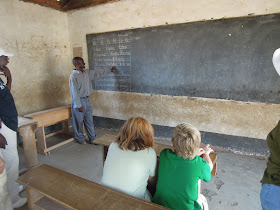 |
| Water well for the school, there is a lock on the tap so it can not be used after school hours |
 |
| The students toilets. One side for the girls and the other side for the boys. There were no doors on these stalls. |
 |
| Wide view of the school yard |
 |
| School play yard |
 |
| Teachers office/lounge |
 |
| I loved this sign:)!! |
It was very interesting to see what a Tanzanian school looked like and it was shocking to know my 2 children had more supplies in our home than the whole school with a population of 700 students. If there was a cheaper way to send books to Tanzania I would love to clear out my bookshelves and send to them. Instead my husband and I will be looking for other ways to help this school in the near future.







It is great that the school is able to provide food for kids who might not eat, otherwise. I recently learned about Kwashiorkor, however, and hope that they are providing protein in the stew. Kwashiorkor is caused by too low of a ratio of protein to overall calorie ratio (at least as I understand it). It is what causes starving children to have distended bellies. It is a horrible disease that ravages the bodies of children in poverty-stricken countries, where they eat a lot of cheap starches.
ReplyDeleteIf they had more supplies would there be a place to store them? This school is really interesting. It seems a lot like a school on the plains when the United States was full of pioneers.
ReplyDeleteWOW, 700 students and 9 teachers! Thanks for sharing your journey.
ReplyDeleteThat was a very interesting post. I would say we are deeply blessed. It is hard to imagine such poor circumstances. It is so sad thatthey don't have more resources. It is interesting that they wear uniforms. The worst was the restrooms. I have learned so much from these adventures. Our church sends humanitarian missinaries in to some of these areas. They help the villagers with getting wells put in for water. We have close friends that served in Africa and India. They have shared some amazing stories.
ReplyDeleteBlessings and hugs!
This was very neat to read. It makes you realize how well we really do have it. I may save this post the next time the kids are whining about "school" conditions....lol. But seriously, if you guys come up with a way to help, please share. This would make a great project!
ReplyDelete